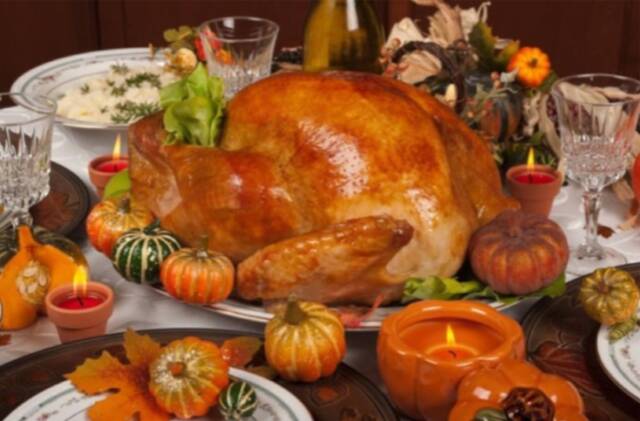Traditionally, turkey has been the centerpiece of the Thanksgiving holiday meal. Although the idea of celebrating thanks and the harvest did not become a national holiday until the 19th century, some parts of the country began to celebrate earlier. Many of these celebrations or feasts included turkey. In fact, turkey became so popular that Alexander Hamilton once remarked, “No citizen of the United States shall refrain from turkey on Thanksgiving Day.” This proclamation by Hamilton became a part of American tradition. Today, according to the National Turkey Federation, about 45 million turkeys are consumed each Thanksgiving.
The preparation of turkey for the Thanksgiving meal has improved over the years. For many cooks, preparing a turkey that was well thawed, safe for consumption, as well as tender and moist upon cooking, was the challenge of the day. Today, there is a wealth of guidance on the internet and TV, as well as your local NC Cooperative Extension Office.
Which turkey should you buy? Several factors can have an impact on the flavor and moistness of your prepared turkey. First of all, according to the National Turkey Federation, there is no difference in quality whether you purchase fresh or frozen. Smaller birds tend to be more tender than large ones. Many labels will indicate whether the birds are “basted” or “self-basting”, this means that the birds have been marinated or injected with a solution of fat, stock, and spices, to increase their moisture. These birds do not require additional brining. Free-range or cage-free birds have the ability to roam around outside, so they tend to have a more robust and complex tasting meat. They may be available from a local producer and are typically more expensive than a conventional bird from your local grocery store.
If you’ve purchased a frozen bird, let’s talk about the thawing process. For food safety purposes, never thaw your turkey on the kitchen counter. Any food left thawing openly for more than two hours is not at a safe temperature. Although the inside may be frozen, the outer layer is in the “danger zone”, between 40º Fahrenheit and 140º Fahrenheit, the temperature where foodborne bacteria begins to multiply rapidly.
The Center for Disease Control (CDC) recommends thawing the turkey in the refrigerator. Estimate 24 hours for every four pounds of turkey to thaw, breast side up, in a leak-proof container on the bottom shelf of the fridge, to prevent cross-contamination from potential drippings. Another thawing method approved by the CDC is the cold water method. This entails placing your turkey in a leak-proof plastic bag in a sink of cold water and changing the water every 30 minutes per pound of bird. Additionally, the CDC advises that turkey can be thawed safely in the microwave following the microwave manufacturer’s instructions. If using the microwave option, plan to cook the turkey immediately because some areas of the turkey may begin to cook during the microwave process and holding would create an environment for bacteria to grow.
Brining is a term we often hear in discussing turkey prep. There are two types of brining, wet and dry. A wet brine consists of submerging the bird in a flavorful salt solution. Wet brines can be flavored with your favorite juice, beer, or spirits. You can also add herbs and spices. It produces a succulent meat and the brine time is 12-24 hours. The process requires a lot of refrigerator space and the skin tends to be less crisp than dry brining. In a dry brine, a salt-spice mixture of your favorite seasonings is rubbed all over the skin of the turkey. A dry brine uses less refrigerator space, but takes longer than a wet brine, about 24-72 hours. It produces a crisp skin. To prep the turkey for cooking, if you dry brined, pat the brine off. If you wet brined, rinse it inside and out with cold water, to remove the excess salt. This is the only time you should rinse a turkey, according to food safety experts at the USDA. Pat dry.
At this stage, brush the outside with olive oil or melted butter, and season the inner cavity and skin as desired with salt, pepper, and herbs. To stuff or not to stuff? Due to food safety concerns, the trend has been against stuffing the bird, instead opting to serve dressing cooked in a separate pan. If you do forgo stuffing, you may want to put cut-up apples, onions, celery and place with herbs in the cavity to add flavor and keep the bird from drying out (dispose of them once the cooking is done). Lastly, tuck the wings and secure the wings and legs with butcher’s twine. Many people have their own theories about what temperature to cook turkey, but the key is to cook it until the food thermometer registers 165º F in the innermost portion of the thigh, the wing, and the thickest part of the breast. The time depends on the oven temperature and the size of the turkey. Allow the bird to rest 15-20 minutes before carving.
For more information about turkey prep and food safety contact Cheri Bennett at N.C. Cooperative Extension, Richmond County Center, at [email protected] or 910-997-8255.
Cheri Bennett is the Family and Consumer Sciences Agent for the Richmond County Cooperative Extension.

